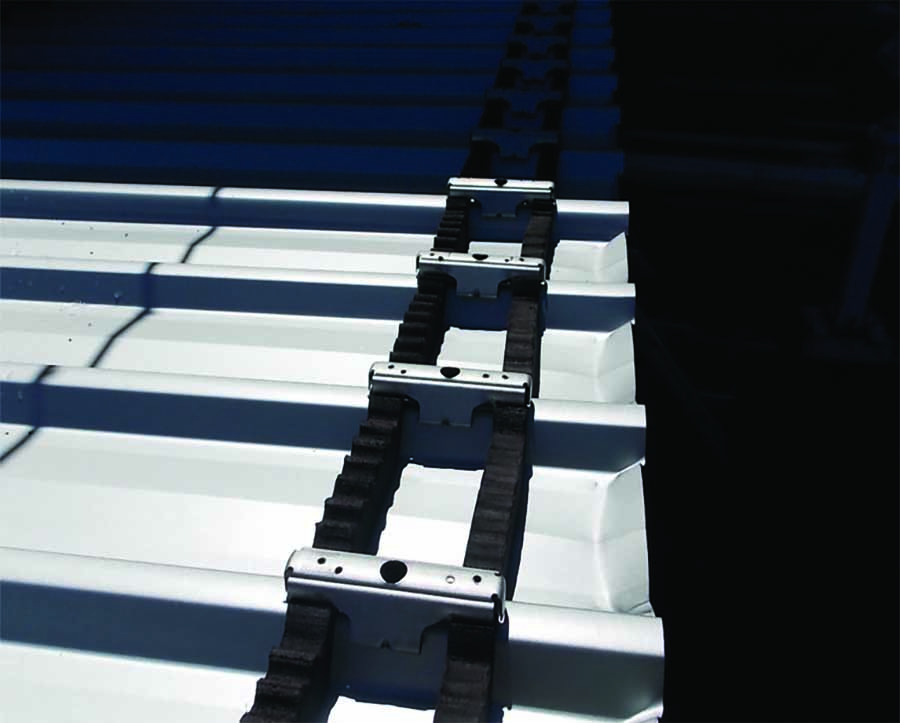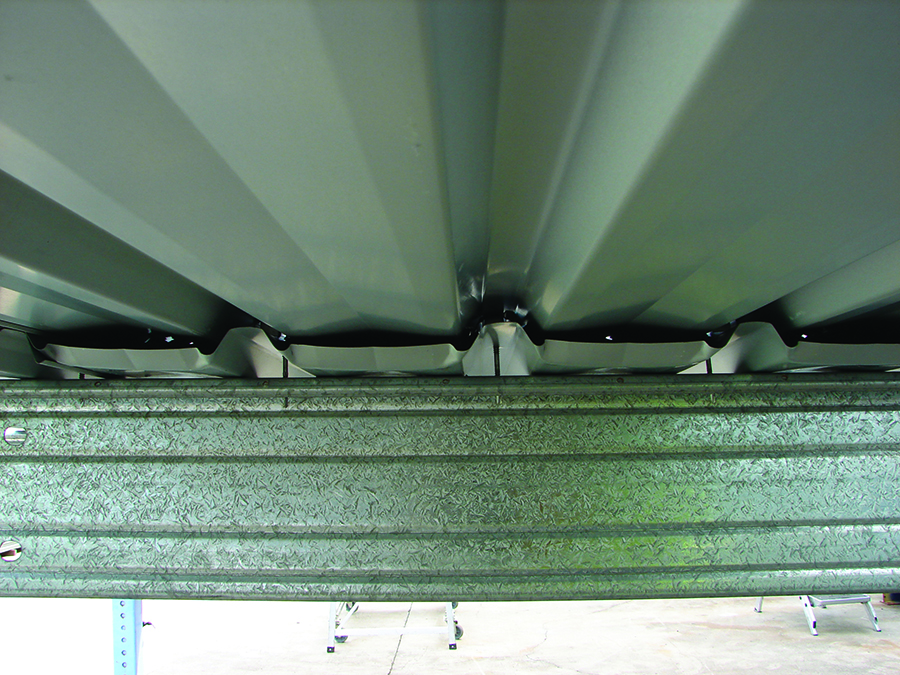Fielders® T-Lap™
NEW END/EXPANSION JOINT SOLUTION FOR Fielders® TL-5™
The T-Lap™ system provides installers with a simple end lap/expansion joint solution for TL-5™ . The T-Lap™ system comprises an engineered bracket and custom profiled weather strip to provide maximum fixing security and weatherproofing. The T-Lap™ bracket is sandwiched between the overlapping sheets and is fixed using standard pierce-fixed screw fasteners.
BENEFITS OF T-Lap™
- Low profile system maintains clean, long run roof lines of roofing.
- A simple cost effective way to achieve a long-length roofing design, even when using shorter roof sheets.
- Minimal change to current installation practice means its fast and easy to install.
- Standard pierce-fixed screw fasteners Tested at our NATA-accredited testing facility.
- If installed correctly, will preserve all existing roofing warranties.
- Safe and effective weather resistant seal.
- Allows for thermal movement of long roof runs.
- No special purlin detailing required - saves you time and money.
- Compatible with translucent sheeting.
T-Lap™ system comprised of brackets which are fixed to the ribs with weather strips.
Figure 1
BACKGROUND ON THERMAL EXPANSION
All metals expand and contract with changes in temperature. Although steel is by far the least affected of all the metals commonly used for roof and wall cladding, the changes in length experienced in very long runs of roofing are significant.
When T-Lap™ is used, the length of each individual sheet is necessarily shorter, thus reducing the impact of thermal movement.
T-Lap™ IS AN EXPANSION JOINT/LAP JOINT HYBRID
An expansion joint involves overlapping the ends of the upper sheets over the ends of the lower sheets. With the T-Lap™ system, no extra purlin is needed at the joint as is the current practice with expansion joints.
A profiled weather strip provides protection from wind-blown rain and is made from closed cell polyethylene foam. It is sandwiched between the upper and lower sheets to provide a weather resistant barrier from wind driven rainwater. It also provides air flow and ventilation to reduce likelihood of potential trapped condensate or moisture build-up.
The T-Lap™ bracket is Australian-made Next Generation ZINCALUME® Steel and is an assembly of two pieces.(Figure 4) The two pieces are pressed metal components (an upper and lower piece) inter-locked together and the assembled bracket saddles the rib of the roofing profile. The bracket, as an assembly, is placed on the rib of the lower sheet and the lower piece (base) of the bracket is fixed, via a pre-formed hole, through the rib to the support underneath. The rib of the upper sheet is pierce-fixed directly to the upper piece of the bracket. The upper piece of the bracket is free to move longitudinally relative to the lower piece.
T-Lap™ system (section view).
Figure 2
T-Lap™ JOINT LAYOUT AND FIXING
The following layout will allow normal pierce-fixed screw fastening at the support and still allow thermal movement to occur at the T-Lap™.
The T-Lap™ system should consist of a T-Lap™ bracket at each rib with weather strips, as per Figure 5. The weather strips are secured in place by being sandwiched between the lower portion of the bracket and the lower roofing sheet. The lower portion of the bracket is secured in-place by the standard roofing screws through the pre-formed hole and through the roofing rib to the support underneath.
The upper roofing sheet is placed so that the ribs sit upon the upper portion of the T-Lap™ bracket. The upper sheet is then fixed to the upper portion of the T-Lap™ bracket using two standard walling screws. Refer to Table 1 for fastener requirements.
TESTING
The T-Lap™ system has been tested for performance in wind uplift and weather-resistance at Fielders® NATA-accredited materials science testing laboratory. This means you can be confident that T-Lap™ will perform to specification when installed according to our design limitations and installation guidelines
Layout details of T-Lap™ system at support.
Figure 5
INSTALLATION
TL-5™ SPAN CONSIDERATIONS
The spans of the roofing at the joint must be kept within the
following limits:
a. The roofing sheets on either side of the T-Lap™ joint are not to exceed the maximum recommended END span of the roofing.
b. The purlin spacing (roofing span) must be of a practical range – typically 900mm or greater.
WEATHER STRIPS
These guidelines describe the laying two rows of weather strips, however in most cases only a single row is required. When using a single row of weather strip (primary weather strip) it must be located on the high side of the T-Lap™ brackets. Two rows of weather strips are recommended in translucent sheet installation or where the roof is exposed to a severe combination of very high wind and high rain. The weather strips are interlocked end-to-end in the traditional way to form a continuous row.
PACKERS
Packers (10mm thick) may be required to achieve a more gradual change in the roof slope and to ensure drainage at the joint. The packer is positioned on the lowest purlin of the upper sheet for roofs at the TRIM-KLIP® joint system (see Figure 9).
Packers would only be required on shallow roof slopes and when the purlin spacing for the end span is close. For roof slopes of 2.5˚ or more with the purlins spacing at a practical range then no packer is required. For roof slopes less than 2.5˚ then a packer is preferred, however if the purlin spacing is 1150mm or less than a packer is recommended.
COMPONENT QUANTITY
The quantity of components required for a run of joint are given in below table
T-Lap™ Assembly Components Quantity
| Component | Continuous run of lap joint (m) | ||||
| 10 | 25 | 50 | 75 | 100 | |
| T-Lap™ (1 per rib) | 54 | 133 | 264 | 395 | 526 |
| Weather strip – 1 row | 11 | 27 | 53 | 79 | 105 |
| Weather strip – 2 rows | 22 | 54 | 106 | 158 | 210 |
| #12-14x45 fasteners (1 per bracket) | 54 | 133 | 264 | 395 | 526 |
| #10-16x16 fasteners (2 per bracket) | 108 | 266 | 528 | 790 | 1052 |
Packer position for gradual roof slope.
Figure 9
TURNING-UP
Turn-ups are performed on the upper end of the lower sheets at the T-Lap™ joint using the standard turn-up tool in the traditional way. Holding the end of the tool against the end of the sheet, pull the handle until the resulting turn-up is approximately 30˚ from horizontal being careful not to tear the cladding (due to the material spring back the handle may need to be pulled to approximately 45˚ from the vertical.) ( Figure 10). The resulting turn-up is to be a little less than 20mm in height.
Turning-up TL-5™ at the T-Lap™ joint.
Figure 10
TURNING-DOWN
The upper sheet at the T-Lap™ joint requires the pans at the lower end to be lipped (turned down) prior to laying the sheets using the traditional turn-down tool. Push the turn-down tool over the end of the pan as far as it will go, then hold the tool hard against the end of the pan and pull the handle until the lipped edge bottoms out on the underside of the pan, resulting in a nominal 20˚ degrees lip (Figure 11). Be careful not to tear the sheet.
In severe exposure conditions of combined very high wind and high rainfall situations, the rib crests of the upper sheets at the T-Lap™ end, may also need to be turned down. For more information refer to our cyclonic literature.
Turning-down the pans at the T-Lap™ end joint.
Figure 11
INSTALLATION PROCESS
The installation of the roofing should generally be in accordance to the instructions given as above, in the Fielders® Roofing and Walling Installation Manual and the TL-5™ brochure. With regard to the installation of the T-Lap™ system the following steps should be followed.
STEP 1: SHEET LAYING SEQUENCE
The laying sequence of the sheets (Figure 12) shall consist of the lower sheets of the roofing prior to the upper sheets as per the sequence shown. The number of sheets laid will depend upon the site conditions and installer programme.
Laying sequence for laying roofing for end joint.
Figure 12
STEP 2: FIXING OF THE LOWER SHEETS
Fix the lower sheets at all supports (Figure 13) other than at the support where the T-Lap™ is to be located.
The pans on the upper end of the lower sheet are to be turned-up prior to fitting weather strips and the T-Lap™ brackets. The turn-up is best completed after the sheets are laid and fixed into position.
Lay lower sheets of TL-5™
Figure 13
STEP 3: MARK POSITION OF BRACKETS
Once the required number of lower sheets is installed, mark the position where the T-Lap™ brackets are to be installed. Use a stringline or straight edge to ensure the position of the brackets is aligned.
Mark the centre of each rib.
STEP 4: PLACE WEATHER STRIPS
Weather strips are installed on top of cladding in continuous rows. (Figure 14) The weather strips are placed to the side of the marker line and in-line with the ends of the T-Lap™ brackets, but not protrude past the T-Lap™ brackets. When two rows of weather strips are used then each row must have the join in alternating pans (i.e. the joins are off-set).
Lay weather strips.
Figure 14
STEP 5: INSTALL BRACKETS
(FIGURE 15)
Position the T-Lap™ brackets on the pre-marked ribs as described in Step 3 and fix as detailed in Figures 1, 2 and 5. Prior to fixing the brackets into position, ensure the weather strips are correctly aligned with the ends of the brackets and ensure the weather strips nest well into the rib/pan corners.
Install T-Lap™ brackets.
Figure 15
STEP 6: LAY UPPER SHEET OVER T-Lap™ (FIGURE 16)
Prepare the upper sheets by turning down the pans (and if required the rib crest) at the lower end of the sheet as detailed.
Position the upper sheets by placing the upper sheet onto the T-Lap™ brackets and align the ends of the sheet to the correct overhang. Ensure that the weather strips are not dislodged, distorted or twisted from position. While standing on the upper sheet, fix the upper sheet to at least two rows of supports prior to fixing at the T-Lap™ joint to ensure correct sheet alignment.
While standing in the pans of the sheet, either side of the inner ribs, fix the T-Lap™ bracket with two screws. Added care should be taken when standing at, and fixing of, the sidelap, and some nominal foot pressure on the side-lap may be prudent. The side-lapping rib should be fixed prior to the inner ribs.
Finish fixing the remainder of the upper sheet to the remainder of the supports.
If packers are required, position on the lowest purlin of the upper sheet prior to positioning of the upper sheets. Take care not to dislodge the installed packer. Longer screws may be required where a packer is used.
Place upper sheet over T-Lap™ brackets.
Figure 16
STEP 7: FINISHING
Continue the above process to the finishing edge/end of the roof.
Progressively clean up all residue and swarf, and clean at the completion of each day and at the end of the job.
The overhanging weather strips can be cut or torn off. It is now ready to receive barge flashing.
NOTE :
• Care should be taken to avoid walking around the T-Lap™ overhang area to prevent damage.
• Safety precautions should be taken when walking on the roof and particularly near the roof edges (both permanent and temporary edges).
• Use of T-Lap™ to our guidelines won’t void any product warranties.

















